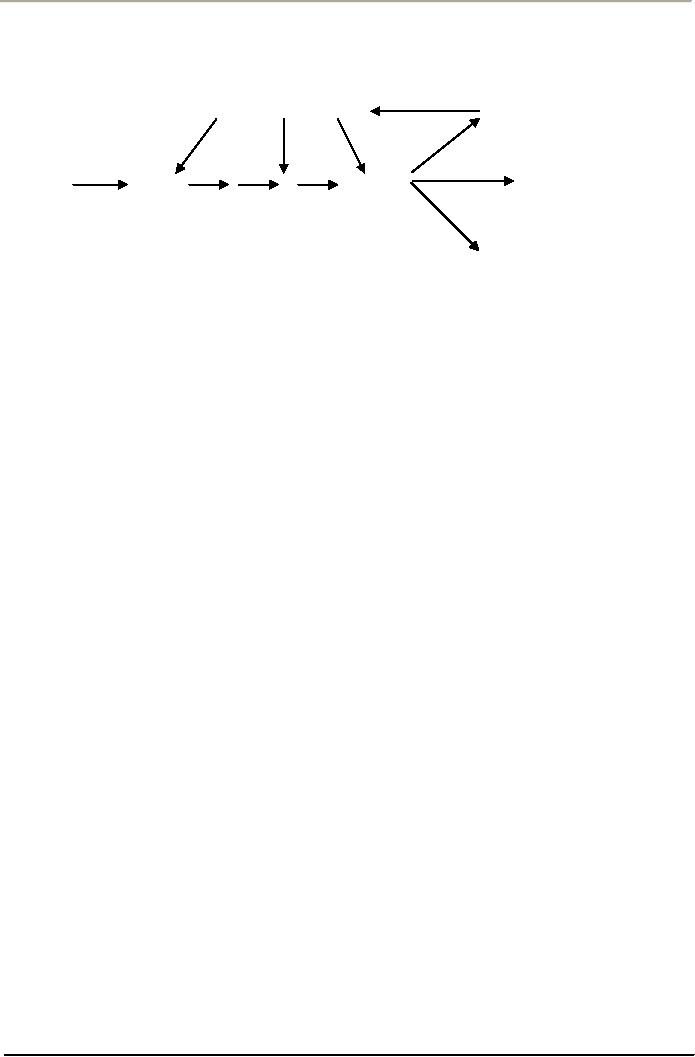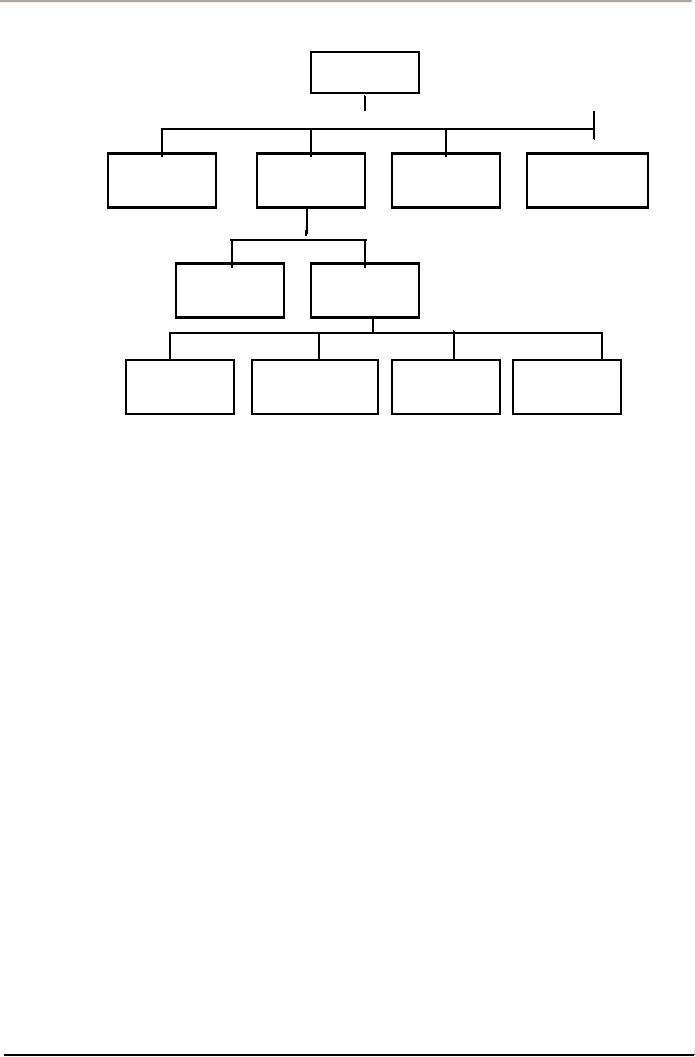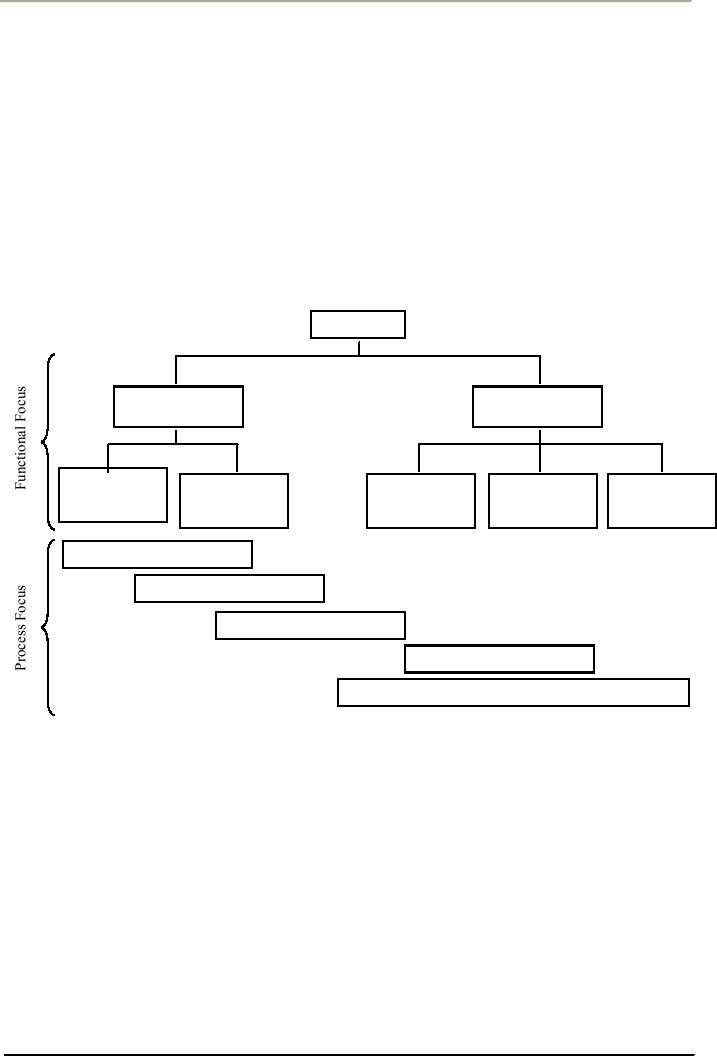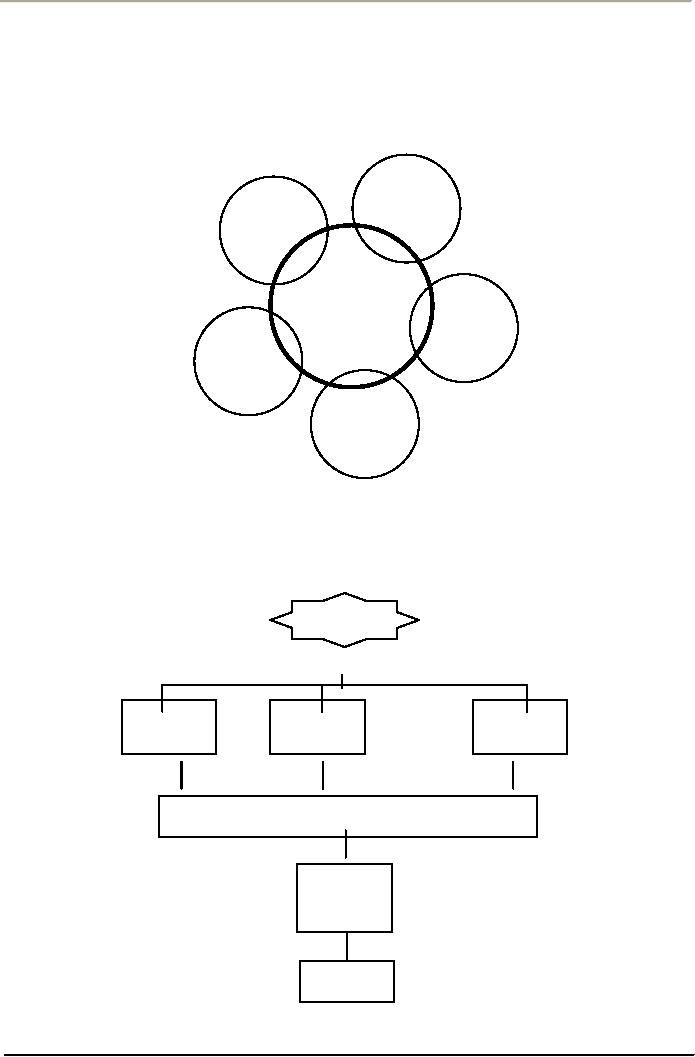 |

Total
Quality Management
MGT510
VU
Lesson
# 31
CREATING
QUALITY AT STRATEGIC, TACTICAL AND
OPERATIONAL LEVEL
In
1950 Deming drew the
following picture on a blackboard
for a handful of Japanese
executives:
Consumer
Design
and redesign
research
Suppliers
Inputs
Outputs
Customers
Processes
Many
people see this as simply a
diagram of a typical Production or
Operation System that is
linked to
customers
and suppliers. Visionaries in the practice of TQ see
this as a new model of an
organization
chart
from a strategic perspective.
The
Functional Structure and
Operations
In
the functional structure, the organization is
divided into functions such
as operations, marketing, MIS
and
maintenance, each of which is headed by a
manager. In such organizations
communication occurs
vertically
up or down the chain of command, rather
than horizontally across
functions. Functional
structures
provide organizations with a clear
chain of command and allow
people to specialize in the
aspect
of the work for which they
are best suited. They also
make it easy to evaluate
people based on a
narrow
but clear set of responsibilities.
For these reasons functional
structures are common in
both
manufacturing
and service organizations at plant and
business unit levels.
Problems
with Functional Structure
Despite
its popularity, the functional structure
is designed primarily for the
administrative convenience
of
the organization, rather than
for providing high-quality service to
customers. From a TQ point
of
view,
the functional structure has several
inadequacies.
The
Functional Structure Separates Employees
from Customers
Few
employees in the functional organization have
direct contact with customers or even a
clear idea of
how
their work combines with the
work of others to satisfy
customers. The functional structure
tends to
insulate
employees from learning about
customer expectations and their degree of
satisfaction with the
service
or product the firm is providing.
Being insulated from
customers encourages in workers
a
narrow
conception of their responsibilities.
This is often expressed in
statements such as "It's not
my
job"
or "I just work here." Even
when such employees want to
help customers, they often
have such a
limited
understanding of how their
organizational system works
that they are unable to do
so. This often
results
in demotivated workers and poor
quality work.
131

Total
Quality Management
MGT510
VU
Functional
Structure for a Manufacturing
Company
President
Marketing
Production
Finance
Engineering
Director
Director
Director
Director
Manager
Manager
Plant
# 1
Plant
# 2
Operations
Quality
Control
Purchasing
Accounting
Manager
Manager
Manager
Manager
Most
of us have experienced this phenomenon when we
call a large organization
trying to get help and
get
switched to several different people
before (if we're lucky)
finding someone willing and
able to help
us.
If our needs as customers
relate to the product or service as a
whole, but the knowledge
and
responsibilities
of anyone with whom we deal
relate only to their
function, we are doomed to
disappointment.
The
Functional Structure Inhibits Process
Improvement
No
organizational unit has
control over a whole
processes, although most
processes involve a
large
number
of functions. This is because
the breakup of the organization
into functions is usually
unrelated
to
the processes used to deliver a
product to the customer. This structure is
likely to create
complex,
wasteful
processes, as people do things in
one area that must be redone
or undone, in another.
For
example, some organization
maintain a group of engineers whose
sole responsibility is to redesign
products
so that they can be manufactured
effectively. The engineers who design the
products in the
first
place worry only about
product performance, not
manufacturability. (For another example
of
problems
in coordinating design and manufacturing.)
Worse yet, if one function
tries to improve its
part,
it may well make things
worse (more wasted time and
effort, more cost) for another
part of the
process.
In this environment, continuous
process improvement doesn't
stand a chance. This
arrangement
obviously
stands in the way of continuous
process improvement. Organizations
pursuing TQ often
retain
their quality assurance
departments, but these units
act more as coaches or facilitators
to
employees,
rather than as the group with
primary responsibility for
quality. In summary, the
functional
organization
compromises total quality in several
ways: It distances people
from customers and
insulates
them from customer expectations. It promotes
complex and wasteful
processes and
inhibits
process
improvement. It separates the quality
function from the rest of
the organization, providing
people
with an excuse for not
worrying about
quality.
Redesigning
Organizations for Quality
Poor
organization design can be devastating to
a company. One of Deming's 14 Points is
to "break
down
barriers between departments" because "people in
various departments must
work as a team."
This
slogan captures in a nutshell what the TQ
philosophy entails for
organizational design. People
cannot
contribute to customer satisfaction and
continuous improvement if they
are confined to
132

Total
Quality Management
MGT510
VU
functional
prisons where they cannot see customers
or hear their voices. Some of the more
effective
ways
to break down these barriers
are to focus on processes, recognize
internal customers, create
a
team-based
organization, reduce hierarchy,
and use steering committees.
Focus
on Processes
A
process is how work creates
value for customers. Common
business process include
acquiring
customer
and market knowledge, fulfilling
customer orders, purchasing, developing
new products or
service,
strategic planning, production or service
delivery, distribution, research and
development,
information
management, performance measurement, and
training, to name just a
few. Individuals or
groups,
known as process owners, are accountable
for process performance and have the
authority to
manage
and improve their process.
Process owners may range from
high-level executives who
manage
cross-functional
processes to workers who run
machinery on the shop floor.
Assigning process owners
ensures
that someone is responsible to manage the
process and optimize its
effectiveness.
Process
versus Function
CEO
Vice
President
Vice
President
Department
Department
Department
Department
Department
Manager
Manager
Manager
Manager
Manager
Process
A
Process
B
Process
C
Process
D
Process
E
A
process focus, as opposed to the
functional structure, is shown below.
Nearly every major
activity
within
a business involves some
form of cross-functional cooperation. A
process perspective links
all
parts
of an organization together and increases
employee understanding of the entire
system, rather than
focusing
on only a small part. In
addition, it helps managers to recognize
that problems arise
from
processes,
not people. By aligning the structure of
an organization with the actual work
processes that
the
organization performs, customers may be
served more effectively. Process
management involves the
design
of processes to develop and deliver
products and services that
meet the needs of customers,
daily
control
so that they perform as
required, and their continual
improvement.
Create
a Team-Based Organization
As
more and more companies accept the
process view of organizations,
they are structuring the
quality
organization
around functional or cross-functional
teams, each of which has the
responsibility to carry
out
and improve one of the organization's
core processes. Depending on the
size of the organization
and
the
nature of the processes, teams may
include everyone who
contributes to a given process or
only a
representative
subset. Similarly, the tams
may meet continuously on a
crash basis until their
new
process
design is complete, after which they
may meet periodically or on an ad hoc
basis whenever
133

Total
Quality Management
MGT510
VU
necessary.
For example, Solectron
Corporation, a two-time Baldrige
recipient, has a customer
focus
team
for each customer that
includes personnel from quality,
manufacturing management,
project
engineering,
sales, production control,
test engineering, and a project
buyer and program manager.
Team
based Organizational Structure at
one Plant
Team
Reps
Council
Safety
Team
Core
Process
Teams
Safety
Reps
Innovation
Team
Quality
Reps
Team-Based
Organizational Chart
Customers
Customer
Customer
Customer
Team
Team
Team
System
and Support Service
Executive
Steering
Committee
CEO
134

Total
Quality Management
MGT510
VU
Strategic
Planning and the Baldrige
Award
The
Baldrige Award recognizes the
importance of integrating total
quality principles with
overall
business
planning. The Strategic Planning
category addresses strategic business
planning and
deployment
of plans. It stresses tat customer-driven
quality and operational performance are
key
strategic
business issues that need to
be an integral part of overall company
planning, and emphasizes
that
improvement and learning must be
integral parts of company work
processes. The special role
of
strategic
planning is to align work
processes with the company strategic
directions, thereby
ensuring
that
improvement and learning reinforce
company priorities.
The
Strategic Planning category examines how
organizations.
�
Plan
for the long term, and understand the key
influences, risks, challenges, and
other
requirements
that might affect the
organization's future opportunities and
directions. This is to
help
ensure that short-term action plans
are aligned with the
organization's longer-term
strategic
directions.
�
Project
the future competitive environment to
help detect and reduce
competitive threats,
shorten
reaction time, and identify
opportunities.
�
Develop
action plans and deploy resources
particularly human resources to
achieve
alignment
and consistency, and provide a basis for
setting and communicating
priorities for
ongoing
improvement activities.
�
Ensure
that deployment will be
effective that a measurement
system enables tracking of
action
plan
achievement in all areas.
The
integration of quality planning
with business planning occurred in the
1995 criteria revision.
Most
symbolic
was the change in the category's
title from "Strategic
Quality Planning" to
"Strategic
Planning."
This change signaled a
"major emphasis on business strategy as
the most appropriate
view-
of-the-future
context for managing
performance." The integration of
quality and operational issues
with
business
planning became a dominant
theme, with a focus on "Performance,"
"Competitive position,"
"Customer-related,"
and "Operational"
themes.
The
ISO-9001 model has still to
work out ways how to
incorporate strategic planning into
business
planning;
however, it does take good
care of tactical and operational
quality control.
135
Table of Contents:
- OVERVIEW OF QUALITY MANAGEMENT:PROFESSIONAL MANAGERIAL ERA (1950)
- TOTAL QUALITY MANAGEMENT AND TOTAL ORGANIZATION EXCELLENCE:Measurement
- INTEGRATING PEOPLE AND PERFORMANCE THROUGH QUALITY MANAGEMENT
- FUNDAMENTALS OF TOTAL QUALITY AND RATERS VIEW:The Concept of Quality
- TOTAL QUALITY MANAGEMENT AND GLOBAL COMPETITIVE ADVANTAGE:Customer Focus
- TOTAL QUALITY MANAGEMENT AND PLANNING FOR QUALITY AT OFFICE
- LEADERS IN QUALITY REVOLUTION AND DEFINING FOR QUALITY:User-Based
- TAGUCHI LOSS FUNCTION AND QUALITY MANAGEMENT
- WTO, SHIFTING FOCUS OF CORPORATE CULTURE AND ORGANIZATIONAL MODEL OF MANAGEMENT
- HISTORY OF QUALITY MANAGEMENT PARADIGMS
- DEFINING QUALITY, QUALITY MANAGEMENT AND LINKS WITH PROFITABILITY
- LEARNING ABOUT QUALITY AND APPROACHES FROM QUALITY PHILOSOPHIES
- TOTAL QUALITY MANAGEMENT THEORIES EDWARD DEMING’S SYSTEM OF PROFOUND KNOWLEDGE
- DEMING’S PHILOSOPHY AND 14 POINTS FOR MANAGEMENT:The cost of quality
- DEMING CYCLE AND QUALITY TRILOGY:Juran’s Three Basic Steps to Progress
- JURAN AND CROSBY ON QUALITY AND QUALITY IS FREE:Quality Planning
- CROSBY’S CONCEPT OF COST OF QUALITY:Cost of Quality Attitude
- COSTS OF QUALITY AND RETURN ON QUALITY:Total Quality Costs
- OVERVIEW OF TOTAL QUALITY APPROACHES:The Future of Quality Management
- BUSINESS EXCELLENCE MODELS:Excellence in all functions
- DESIGNING ORGANIZATIONS FOR QUALITY:Customer focus, Leadership
- DEVELOPING ISO QMS FOR CERTIFICATION:Process approach
- ISO 9001(2000) QMS MANAGEMENT RESPONSIBILITY:Issues to be Considered
- ISO 9001(2000) QMS (CLAUSE # 6) RESOURCES MANAGEMENT:Training and Awareness
- ISO 9001(2000) (CLAUSE # 7) PRODUCT REALIZATION AND CUSTOMER RELATED PROCESSES
- ISO 9001(2000) QMS (CLAUSE # 7) CONTROL OF PRODUCTION AND SERVICES
- ISO 9001(2000) QMS (CLAUSE # 8) MEASUREMENT, ANALYSIS, AND IMPROVEMENT
- QUALITY IN SOFTWARE SECTOR AND MATURITY LEVELS:Structure of CMM
- INSTALLING AN ISO -9001 QM SYSTEM:Implementation, Audit and Registration
- CREATING BUSINESS EXCELLENCE:Elements of a Total Quality Culture
- CREATING QUALITY AT STRATEGIC, TACTICAL AND OPERATIONAL LEVEL
- BIG Q AND SMALL q LEADERSHIP FOR QUALITY:The roles of a Quality Leader
- STRATEGIC PLANNING FOR QUALITY AND ADVANCED QUALITY MANAGEMENT TOOLS
- HOSHIN KANRI AND STRATEGIC POLICY DEPLOYMENT:Senior Management
- QUALITY FUNCTION DEPLOYMENT (QFD) AND OTHER TOOLS FOR IMPLEMENTATION
- BASIC SQC IMPROVEMENT TOOLS:TOTAL QUALITY TOOLS DEFINED
- HOW QUALITY IS IMPLEMENTED? A DIALOGUE WITH A QUALITY MANAGER!
- CAUSE AND EFFECT DIAGRAM AND OTHER TOOLS OF QUALITY:Control Charts
- STATISTICAL PROCESS CONTROL (SPC) FOR CONTINUAL QUALITY IMPROVEMENT
- STATISTICAL PROCESS CONTROL….CONTD:Control Charts
- BUILDING QUALITY THROUGH SPC:Types of Data, Defining Process Capability
- AN INTERVIEW SESSION WITH OFFICERS OF A CMMI LEVEL 5 QUALITY IT PAKISTANI COMPANY
- TEAMWORK CULTURE FOR TQM:Steering Committees, Natural Work Teams
- UNDERSTANDING EMPOWERMENT FOR TQ AND CUSTOMER-SUPPLIER RELATIONSHIP
- CSR, INNOVATION, KNOWLEDGE MANAGEMENT AND INTRODUCING LEARNING ORGANIZATION